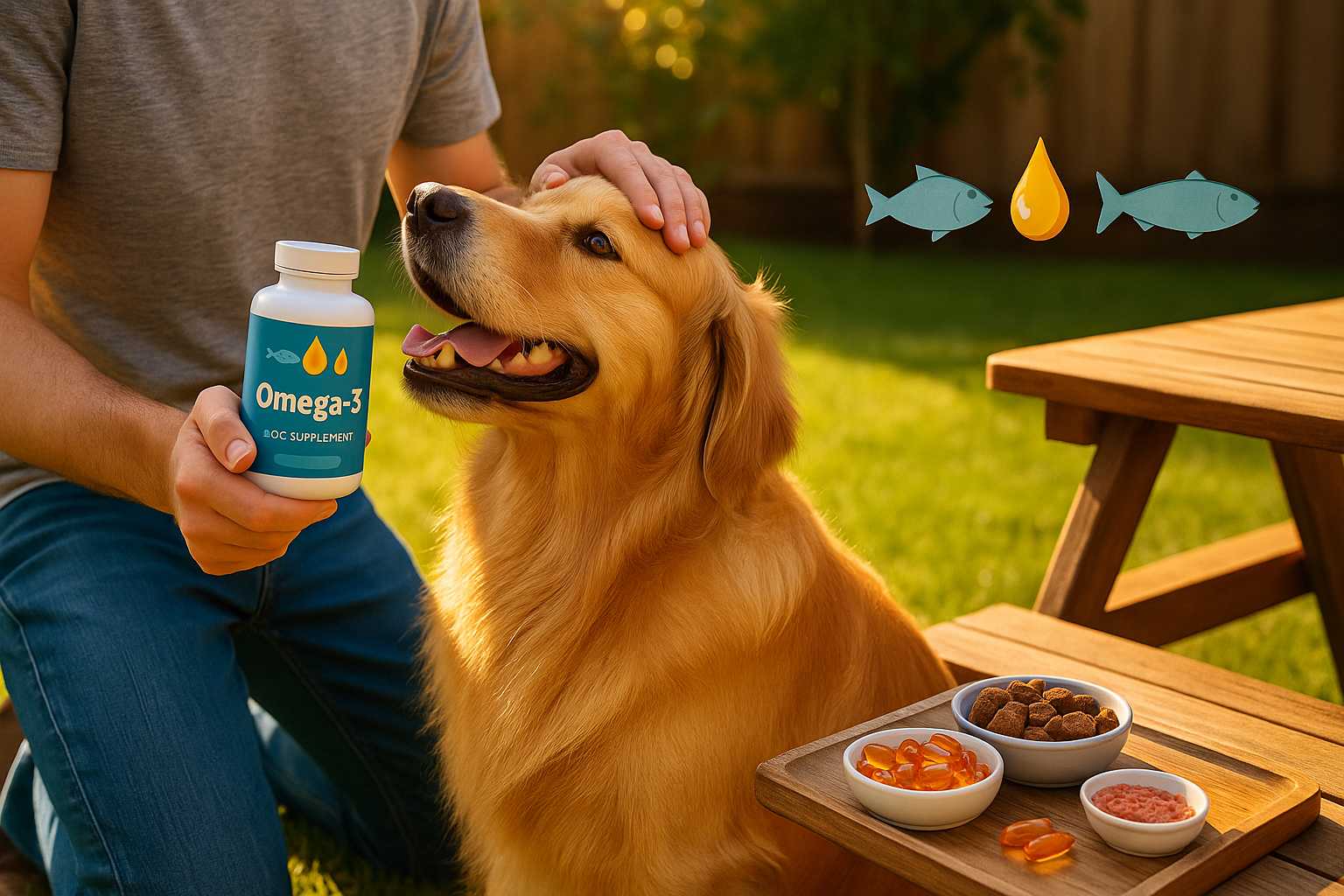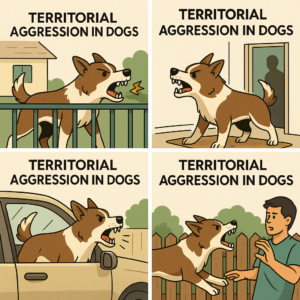Medical Disclaimer: This article is for informational purposes only and is not a substitute for professional veterinary advice. Always consult your veterinarian before starting any supplement.
Table of Contents
Introduction
If you’ve ever stroked your dog’s fur and noticed dullness, flaking, or excessive shedding, you’re not alone. In my Ottawa practice, I’ve had countless pet owners ask how to restore their dog’s glossy coat especially during the dry winter months. The good news? Omega‑3 supplements for dog coat health have become one of the most reliable tools in my clinical toolkit. These fatty acids don’t just improve skin and fur appearance they help tackle underlying inflammation and support the skin barrier from the inside out.
Years of research support their benefits. One 2007 JAVMA review found visible improvements in canine coat quality within just a few weeks of starting EPA and DHA supplementation. More recently, studies have compared delivery forms from fish oil to krill oil finding real differences in absorption and results. But not all products are created equal, and not every dog responds the same way.
In this comprehensive guide, I’ll walk you through everything you need to know about omega‑3 supplements for dog coat health what to choose, how to use them, and how to spot signs they’re working. Whether you’re caring for a senior Labrador with chronic dandruff or a young doodle with seasonal itching, you’ll find practical answers rooted in real veterinary experience and peer-reviewed science.
🐾 Key Takeaways
- Omega‑3 supplements for dog coat health can improve shine, reduce itching, and support skin moisture within 4–8 weeks.
- Dogs can’t convert plant-based ALA efficiently EPA and DHA from fish or krill oil are most effective.
- Liquid, soft chew, or krill-based formats offer different advantages; krill may absorb better, according to recent studies.
- A balanced omega‑6:3 ratio (ideally 5:1 to 10:1) is crucial for coat benefits.
- Look for third-party tested products with clear EPA/DHA content and added vitamin E for oxidative stability.
- Consult your vet before use especially if your dog has clotting disorders or is on immunosuppressive drugs.
Why Omega‑3s Matter for Dog Coat Health
you can visit: https://doglifeexpert.com/top-proven-treatments-for-dog-yeast-infections/

Skin and coat issues are some of the most common complaints I see in clinical practice. While external treatments like shampoos and ointments can help, they often only mask the symptoms. The real solution lies deeper in the skin’s cellular makeup and inflammatory balance. That’s where omega‑3 supplements for dog coat health come in.
Dogs Can’t Convert ALA Well
Unlike humans, dogs are inefficient at converting alpha-linolenic acid (ALA) into EPA and DHA, the active long-chain omega-3s. A study published in the International Journal of Current Microbiology and Applied Sciences found that dogs have very limited enzymatic capacity to elongate ALA into its more biologically active forms. This means that omega‑3 supplements for dog coat health, specifically those containing EPA and DHA from fish or krill oil, are essential for visible coat and skin improvements.
Skin Barrier & Anti-Inflammatory Effects
One of the most impactful roles of omega‑3s is their anti-inflammatory power. Inflammation in the skin often shows up as itchiness, flakiness, and poor coat texture. EPA competes with arachidonic acid (an omega-6) in cell membranes, lowering the production of inflammatory prostaglandins and leukotrienes. According to research published in JAVMA, this mechanism helps restore the skin’s moisture barrier and elasticity. I’ve seen dry, brittle coats transform into soft, shiny fur within weeks when omega‑3 supplements for dog coat health are introduced.
Krill oil, which delivers EPA and DHA in phospholipid form, may further improve tissue uptake possibly explaining why some dogs respond better to krill-based omega‑3s than standard fish oil. This was highlighted in a 2017 comparative study by ( Corbee et al., 2017 ).
These effects underscore that omega‑3 supplements for dog coat health aren’t just cosmetic fixes they offer a science-based strategy to reduce inflammation and support skin integrity at the root level.
Scientific Evidence: What the Research Shows
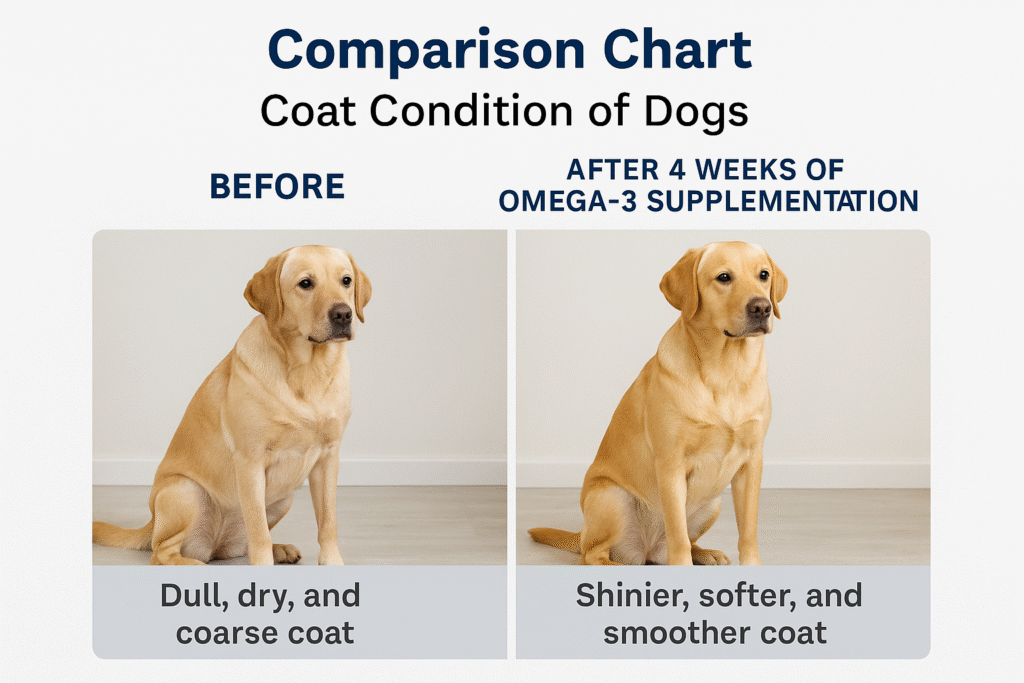
When clients ask if supplements truly work, I always point them to the data. There’s a robust body of veterinary literature showing that omega‑3 supplements for dog coat health deliver measurable benefits, often within the first few weeks.
JAVMA Review: Rapid Improvement in Coat Condition
In a widely referenced ( Bauer et al., 2007 – JAVMA ) , dogs receiving diets enriched with EPA and DHA exhibited noticeable improvements in coat shine, texture, and reduced flaking within 28 days. These outcomes mirror what I’ve seen in clinical settings, especially in dogs who were previously on high omega-6, low omega-3 diets.
Pruritus and Self-Trauma Reduction
An ( AVMA Review, 2011 ) examined the effects of fish oil on inflammatory skin disease in dogs. The study found significantly reduced itching and self-trauma in the group receiving omega‑3s, supporting their use as adjunct therapy in allergic and seborrheic skin conditions.
I’ve personally witnessed cases where introducing omega‑3 supplements for dog coat health allowed clients to taper off medications especially during allergy season when paired with grooming and dietary changes.
Importance of Omega-6 to Omega-3 Ratio
While omega‑3s are vital, their ratio to omega-6s is equally important. A 2007 study by Kirby, Hester, and Bauer found that maintaining a dietary omega-6:3 ratio between 5:1 and 10:1 yielded the best coat quality results. Given that many commercial dog foods are omega‑6 heavy due to vegetable oils, balancing with omega‑3s through targeted supplementation becomes essential.
Fish Oil vs Krill Oil: Absorption Differences
Not all omega‑3 sources are equal. A comparative study published on Academia.edu found that krill oil, due to its phospholipid-bound EPA and DHA, increased tissue omega-3 levels more efficiently than triglyceride-based fish oil. After six weeks, dogs on krill meal had a higher omega-3 index and lower systemic omega-6 markers strong evidence for its superior absorption.
In practice, I often recommend krill oil for dogs who have had minimal response to traditional fish oils or suffer from digestive issues that affect fat absorption.
These findings reinforce the idea that omega‑3 supplements for dog coat health are both clinically effective and biochemically logical especially when tailored to the individual dog’s needs.
Choosing the Best Omega‑3 Supplement for Coat Health
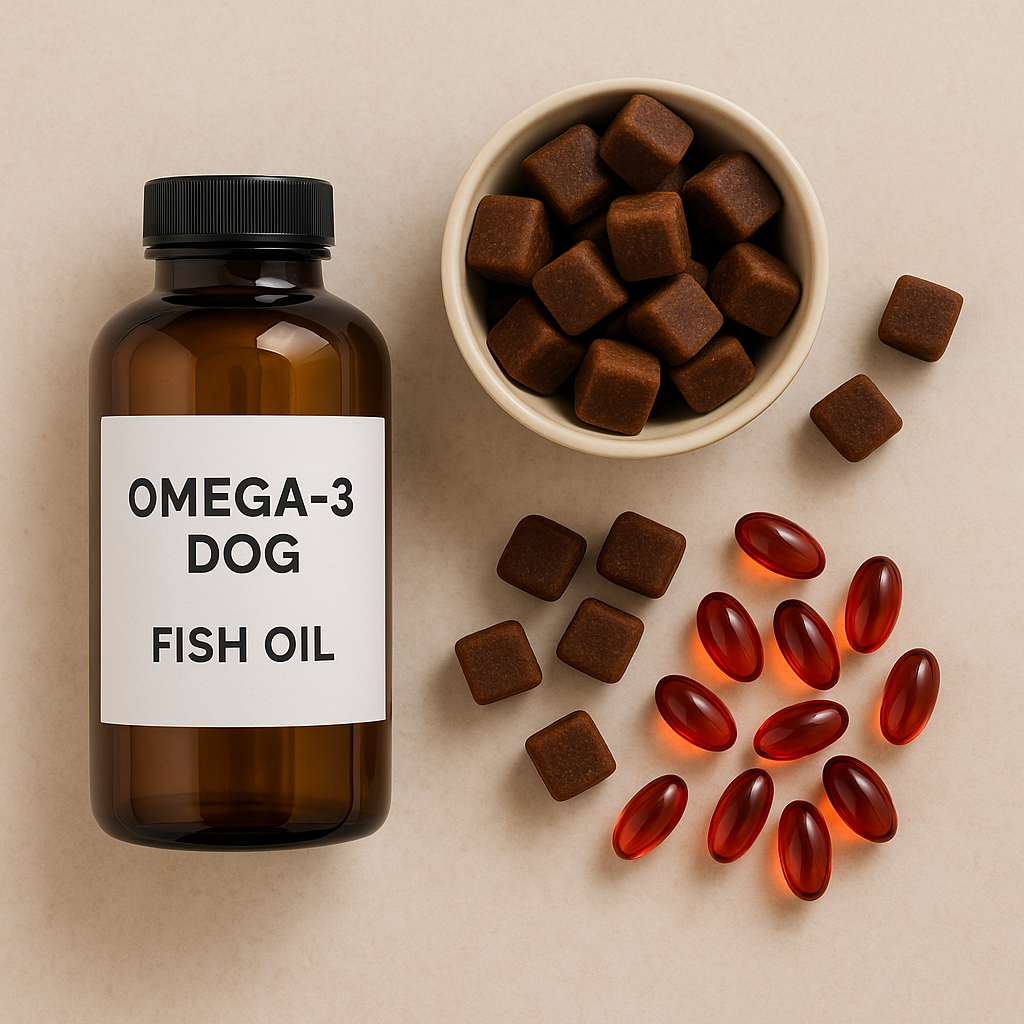
Not all supplements are created equal and as a veterinarian, I’ve seen firsthand how much the right formulation can impact outcomes. To get the full benefit of omega‑3 supplements for dog coat health, it’s essential to choose wisely.
Prioritize EPA and DHA Content
Dogs cannot efficiently convert ALA (from flaxseed, chia, etc.) into EPA and DHA, the omega‑3s responsible for skin and coat improvements. Always read the label and ensure the product clearly lists EPA and DHA amounts per serving. A liquid that only says “omega‑3s” or “fish oil” without detailing its active components may not be effective.
Veterinary nutrition studies, including those published by the AVMA and ResearchGate, consistently point to EPA and DHA as the key players in improving coat texture, reducing flakiness, and supporting dermal health.
Check the Omega‑6 to Omega‑3 Ratio
Look for a product that helps balance the total dietary omega‑6:3 ratio. Most commercial dog foods contain omega‑6s in excess (up to 20:1), so supplementation should aim to bring that ratio closer to the ideal 5:1 to 10:1. The 2007 JAVMA study by Kirby and colleagues showed that dogs on adjusted fat ratios had better coat outcomes by week seven.
Some advanced supplements now list their intended omega-6:3 balance on the packaging, which makes evaluation easier for owners and veterinarians alike.
Choose the Right Delivery Form
There are three main formats of omega‑3 supplements for dog coat health:
- Liquid oils: Often the most concentrated and cost-effective. Best for dogs that accept food toppers.
- Soft chews or capsules: Great for picky eaters or those needing portability. Often flavoured for palatability.
- Krill-based phospholipids: May provide better absorption and fewer side effects, according to Corbee’s 2017 research. These can be more expensive but worth it for sensitive dogs or non-responders to standard oils.
In my practice, I often start with liquid fish oil for ease and adjust based on the dog’s digestive tolerance and coat response.
Ensure Purity and Stability
Since omega‑3s are polyunsaturated fats, they’re prone to oxidation, which can cause rancidity and reduce their benefits. Always choose products that are:
- Third-party tested for purity and heavy metals (e.g., mercury)
- Stored in dark bottles with clear expiry dates
- Supplemented with vitamin E to prevent oxidative damage
I advise clients to refrigerate all opened oils and use them within 60 days to maintain freshness.
With these criteria in mind, finding the right omega‑3 supplement for dog coat health becomes much simpler and far more effective.
How to Use Omega‑3s for Visible Results
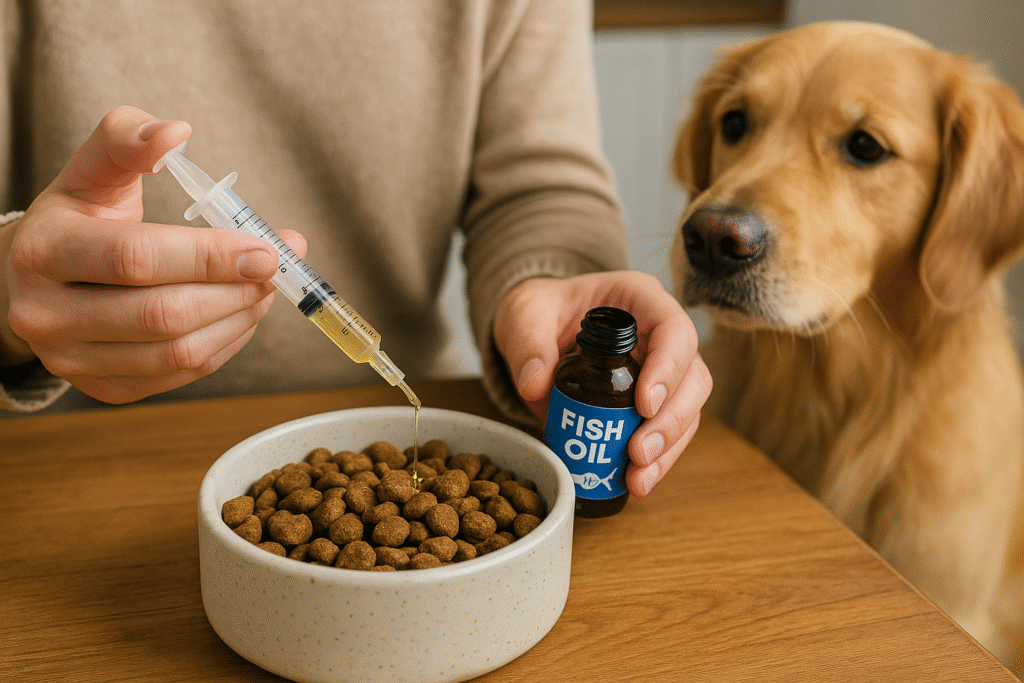
Once you’ve selected a quality supplement, the next step is making sure it’s used correctly. Many pet owners ask, “How long until I see results?” or “What’s the right dose for my dog?” The answers depend on consistency, formulation, and your dog’s individual needs. Here’s how to make omega‑3 supplements for dog coat health work effectively.
Dosing Guidelines Based on Weight
The most widely accepted dosing formula comes from Dr. Bauer, as cited in a JAVMA article, which recommends approximately:
- 220 mg of combined EPA + DHA per kg of body weight daily
- That’s about 1 gram of fish oil per 10 pounds (4.5 kg) of dog weight
For example:
- A 10 kg dog needs ~2,200 mg of combined EPA + DHA per day.
- A 25 kg dog would benefit from ~5,500 mg per day.
Many commercial products already calculate appropriate dosages by weight, but always check the label and consult your vet to avoid underdosing or overdoing it.
Timeline of Effects
Studies show that most dogs demonstrate noticeable coat improvements within 4 to 8 weeks of starting daily omega‑3 supplements for dog coat health. Some may respond even sooner, especially if they were previously deficient or had an imbalanced omega‑6:3 ratio in their diet.
From my clinical experience, dogs with dry, static-prone coats often respond quickest, while those with underlying allergies or hormonal conditions may need adjunctive veterinary care alongside omega‑3 supplements for dog coat health.
Managing Side Effects and Digestive Upset
The most common side effect is mild diarrhea or loose stools, particularly when starting at full dose. To minimize this:
- Start at half dose for the first 3–5 days
- Always give with food
- Consider switching to krill oil if GI upset persists, as phospholipid forms tend to be easier on digestion ( Corbee et al., 2017 )
If your dog is on anticoagulants, corticosteroids, or NSAIDs, check with your vet first high doses of omega‑3s can affect platelet function and immune modulation, though this is rare in typical supplement ranges.
Daily Compliance Matters
Like brushing your teeth, the benefits of omega‑3 supplements for dog coat health depend on consistency. Missed doses reduce efficacy, so integrate the supplement into your daily feeding routine. Use reminder apps or place the bottle near your dog’s food to build a habit.
By following correct dosing and staying consistent, most owners can expect to see their dog’s coat looking glossier, healthier, and less irritated within a couple of months.
Veterinarian-Recommended Product Features
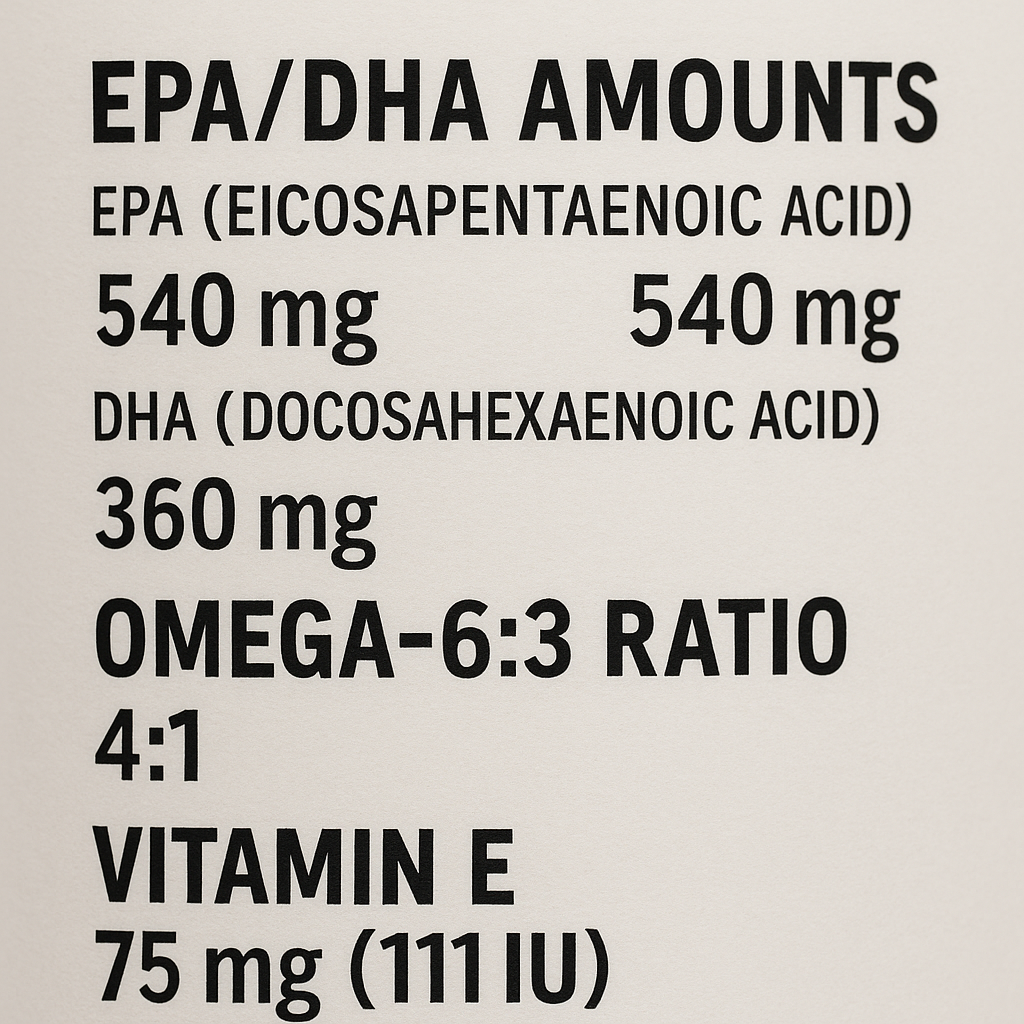
As a vet, I’ve been asked dozens of times, “Which brand do you trust most?” While I don’t endorse specific commercial products in this article, I can tell you what to look for in a top-tier formula. High-quality omega‑3 supplements for dog coat health share common traits that ensure both safety and effectiveness.
Common Supplement Formats
Each supplement format has its own strengths, and choosing the right one depends on your dog’s preferences and your convenience. When selecting among omega‑3 supplements for dog coat health, it’s important to match the format to your dog’s dietary habits and tolerance.
Liquid Fish Oil
Often the most economical per mg of EPA/DHA, liquid fish oil is a go-to for many pet owners using omega‑3 supplements for dog coat health. Look for options with clear dosing instructions and minimal additives. It’s ideal for mixing into meals but prone to oxidation store it in the fridge after opening and use within 60 days.
Soft Chews
Perfect for picky eaters who dislike capsules, soft chews are one of the most popular formats of omega‑3 supplements for dog coat health. These are usually flavoured with salmon, liver, or bacon to enhance palatability. Be sure to choose chews that are third-party tested for purity, with certifications from NASC or IFOS.
Gel Capsules
Gel capsules are convenient for travel or dosing larger dogs. Many owners find success hiding them in treats like peanut butter or cheese. For dogs prone to fishy burps, look for enteric-coated options. Capsules are a reliable way to deliver omega‑3 supplements for dog coat health when accurate dosing and storage are priorities.
Krill-Based Supplements
These typically come in small softgels or powders and may offer superior bioavailability. According to a study published on Academia.edu, krill oil improved omega-3 index levels and reduced omega-6 concentrations more efficiently than standard fish oil. Krill-based omega‑3 supplements for dog coat health also contain natural astaxanthin, which provides antioxidant support.
What to Look for in a Label
When reviewing a product’s packaging, make sure it includes the following:
- Clear EPA and DHA levels per dose
This helps with accurate dosing. Avoid vague terms like “fish oil blend” without specifics. - Third-party testing
Look for certifications from organizations like the National Animal Supplement Council NASC or IFOS (International Fish Oil Standards). - Added Vitamin E
To prevent oxidation of polyunsaturated fats, particularly important in high-dose omega‑3 products. - No unnecessary additives
Avoid artificial colours, sweeteners like xylitol (toxic to dogs), or excessive preservatives. - Sustainability sourcing
Bonus points for oils sourced from wild-caught fish or sustainably harvested krill good for your pet and the planet.
By focusing on these features, you can ensure you’re giving your dog the best possible support through omega‑3 supplements for dog coat health, without wasting money on subpar formulas.
Cautions & Limitations of Omega‑3 Supplementation

While I’ve seen many dogs thrive with omega‑3 supplements for dog coat health, it’s not a magic bullet and it’s important to recognize when omega‑3s alone may not be enough. Here’s what every pet owner should know before starting a regimen.
When Omega‑3s Might Not Help
If your dog’s coat problems stem from:
- Parasitic infestations (e.g., fleas, mites)
- Endocrine disorders (e.g., hypothyroidism, Cushing’s disease)
- Food or environmental allergies
…then omega‑3 supplements for dog coat health may only offer partial relief. In these cases, you’ll need to address the root cause with appropriate diagnostics and treatment. I always remind clients: supplements are a supportive therapy, not a substitute for medical intervention.
For example, I once treated a golden retriever with chronic flaking and hair thinning. Despite two months on a high-quality fish oil, her coat didn’t improve. Blood work later confirmed hypothyroidism. Once we began thyroid medication, the omega‑3 supplements for dog coat health helped her coat recover beautifully.
Potential Side Effects and Drug Interactions
For most dogs, omega‑3s are extremely safe. However, side effects can include:
- Mild diarrhea or soft stools (especially at high doses)
- Fishy breath or body odour
- Decreased platelet aggregation, which could increase bleeding risk (rare at standard dosages)
Dogs with bleeding disorders or those on medications like:
- NSAIDs (e.g., carprofen)
- Steroids (e.g., prednisone)
- Blood thinners (e.g., clopidogrel, aspirin)
…should only use omega‑3 supplements for dog coat health under veterinary supervision. A 2020 review in the International Journal of Current Microbiology and Applied Sciences emphasized this caution, especially for dogs with immune-mediated or cardiovascular conditions.
Product Quality Matters
Poor-quality or rancid oils may cause more harm than good. Rancid omega‑3s generate free radicals that can damage cells and worsen inflammation exactly what we’re trying to avoid. That’s why product sourcing, third-party testing, and freshness matter just as much as EPA and DHA content in any omega‑3 supplements for dog coat health you choose.
In summary, while omega‑3 supplements for dog coat health are generally low-risk and highly beneficial, they should be used with informed caution especially when underlying health issues or medications are involved.
Summary Table: Benefits of Omega‑3 Supplements for Dog Coat Health
To help you quickly understand the evidence behind these supplements, here’s a simplified table linking coat-related benefits to published veterinary research:
| Benefit | Scientific Source |
|---|---|
| Enhanced coat shine & texture | Bauer et al., JAVMA 2007 Kirby, Hester & Bauer, JAVMA 2007 |
| Reduced itching and self-trauma | AVMA Therapeutic Use Review, 2011 |
| Improved skin barrier function | Kaur et al., IJCMAS, 2020 AVMA Skin Physiology Review – Dog Skin Disorders (Wikipedia) |
| Superior absorption from krill oil | Corbee et al., Academia.edu, 2017 |
| Faster response in phospholipid form | Academia.edu Omega-3 Index Study, 2017 |
| Balanced omega-6:3 ratios improve results | Kirby et al., JAVMA, 2007 |
This synthesis shows that omega‑3 supplements for dog coat health aren’t just hype they’re grounded in peer-reviewed veterinary studies and clinical outcomes. While results can vary by individual, the trends are consistent: dogs supplemented with EPA and DHA generally experience measurable improvements in skin and coat condition.
Conclusion
After years of clinical practice, I can confidently say that omega‑3 supplements for dog coat health remain one of the most valuable, low-risk tools we have to improve canine skin and coat conditions. They’re not a cure-all but when used correctly, they can significantly boost coat shine, reduce itching, and support your dog’s overall skin resilience.
Whether you choose a liquid fish oil, soft chew, or krill-based formula, the key lies in selecting a product rich in EPA and DHA, dosed appropriately, and used consistently over time. Don’t expect overnight miracles, but do expect noticeable improvements within 4 to 8 weeks especially if your dog’s current diet is high in omega‑6s or lacks marine-sourced fats.
Always involve your veterinarian in the process, especially if your dog is taking medications or has pre-existing conditions. Supplements should complement not replace professional care.
From senior dogs with thinning coats to young pups with seasonal itch, I’ve seen omega‑3 supplements for dog coat health make a visible and lasting difference. Start smart, stay consistent, and you’ll likely see your dog’s inner health reflected in a shinier, healthier coat.

